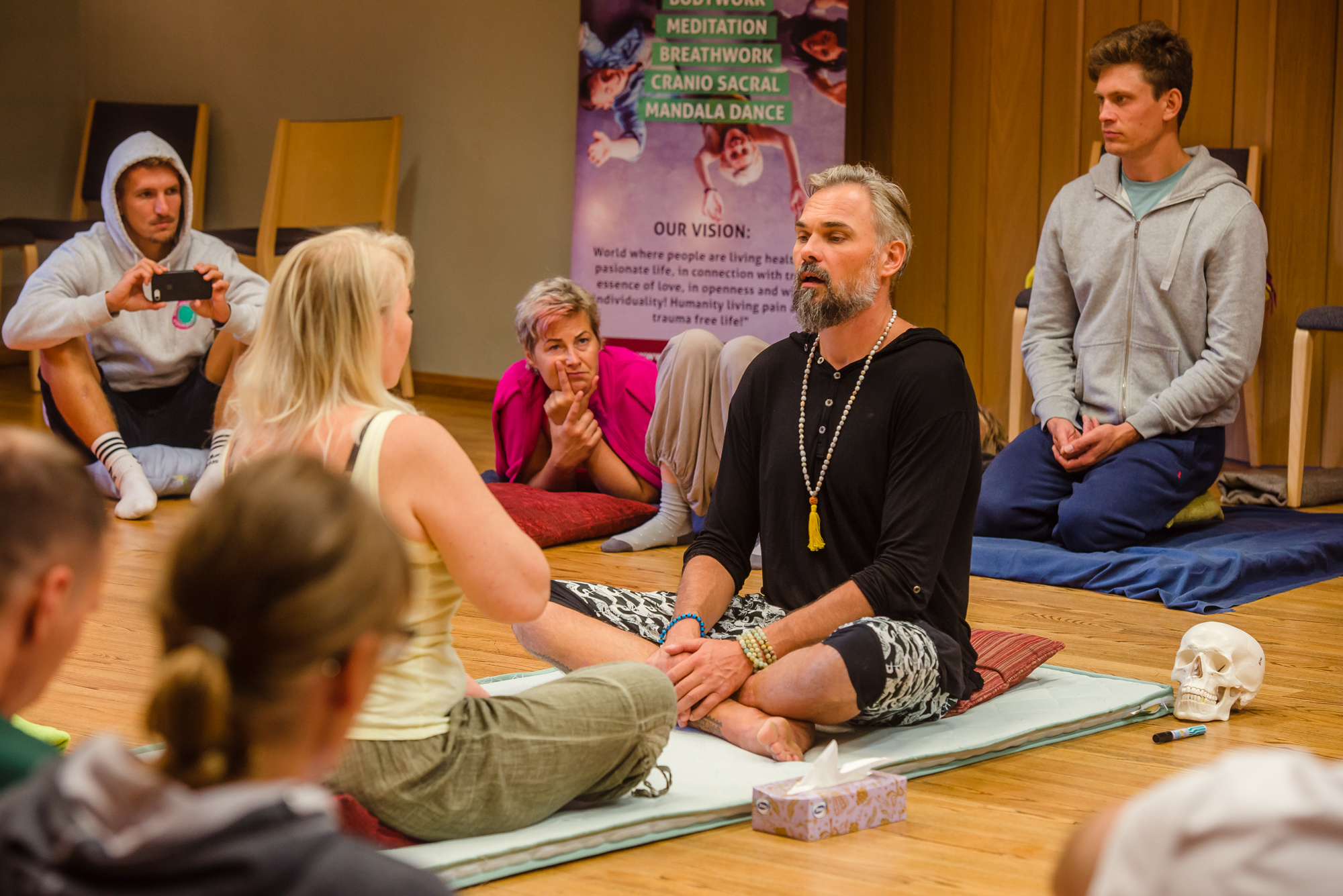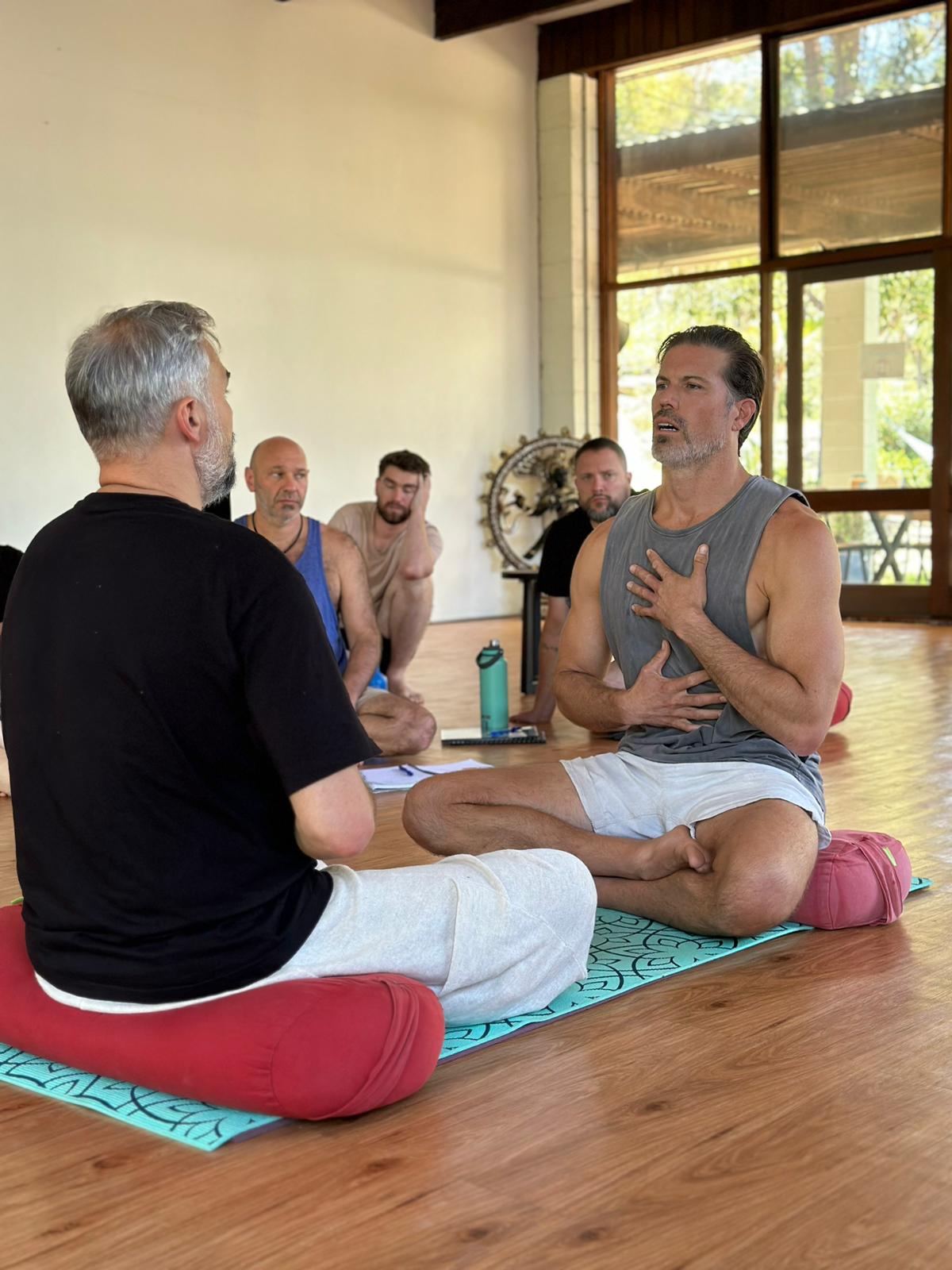Text from the series “Holistic Healing Chronicles: Nourishing Your Body, Mind, and Soul for Lasting Wellness” by Nisarga Eryk Dobosz.
Greetings to all fellow seekers of healing and self-discovery!
In the enchanting winters of 2008-2011, in the vibrant heart of Goa, India, I had the privilege of being a student to the extraordinary therapist, Akash. Not only was she a master in Transactional Analysis, she was also a Sufi and Gurdjieff movement teacher. Her teachings were profoundly transformative, guiding me on a journey of self-discovery. Akash taught me a great deal about myself and therapy. The experience left an indelible mark, unraveling layers of understanding about myself with her masterful guidance, reflective mirroring, and thought-provoking questions. She was one among many other teachers for whom I feel deep gratitude in my life.
Over the past 25 years of my career as a holistic therapist, I’ve delved into various modalities, emphasizing the essence of developing 13 pivotal therapeutic skills for facilitating both individual and group sessions. Allow me to share a glimpse of these skills that have shaped my approach:
1. Create Safety:
Establishing a secure and nurturing environment is paramount in therapeutic practice. Our presence, tone of voice, confidence, loving demeanor, kindness, and peaceful attunement are just a few of the attributes we can deliberately cultivate to foster a sense of safety for our clients.To embody this, it’s essential to incorporate humility into our approach. Taking deliberate steps, I personally allocate 10-15 minutes before each session to meditate. This allows me to arrive at a state of deep presence, connecting with myself and attuning to the nuances of my own body. Maintaining a delicate balance of awareness, I consciously allocate 50% of my focus to self-reflection and 50% to the client. This intentional distribution enables me to keenly monitor the present moment, facilitating a continuous process of releasing any tension or distractions. This ritual of mindful preparation ensures that, as the client steps into the session, they are greeted by a warm and present welcome. This initial embrace often acts as an invitation, seamlessly guiding clients to naturally immerse themselves in the serene and peaceful field of awareness that we collectively create.
2. Resonance and Attunement:
Let’s draw inspiration from the resonance of an empty guitar chamber, wherein striking the strings generates a sound that reverberates within the emptiness and projects outward; our approach to therapy mirrors this. Just as the guitar chamber empties itself to enhance resonance, we, as therapists, embark on a journey of self-emptying to deeply attune ourselves with our clients. Just like an antenna finely tuned to capture the most subtle vibrations, our state of attunement allows us to become witnesses to our own bodies. In this heightened state, we consciously let feelings, thoughts, and sensations pass through us like clouds drifting across the sky. This process unfolds in a non-judgmental state, characterized by acceptance of clients as they are, coupled with a compassionate understanding of their struggles and suffering.
By relinquishing any inclination to do, fix, or change, we create an atmosphere where clients feel the genuine authenticity of our presence. This absence of an agenda fosters an environment of relaxation and trust in the therapeutic process. Clients sense that we are not seeking to alter their experiences but rather to accompany them on their journey, and this realization becomes a cornerstone of the therapeutic alliance.
3. Recognize Triggered Responses:
In the intricate dance of therapy, it’s important to develop a heightened awareness of our own triggers. This requires both mindfulness and a keen understanding of our bodily reactions. There are moments when a client’s defense mechanisms or narratives can evoke intense processes within us as therapists, leading to what’s known as countertransference. The recognition of countertransference requires our awareness and maturity. It’s crucial not to exploit the perceived superiority inherent in our role. The initial step in navigating this terrain is to consciously acknowledge the trigger, observing its manifestation within the body. Following this acknowledgment, a thoughtful process unfolds. The therapist takes intentional steps to own the trigger, acknowledging its presence without judgment. Subsequently, a deliberate release of the trigger occurs, allowing the therapist to let go and return to a state of full attunement. This process is a journey back to the core qualities of resonance, kindness, patience, and compassion. By actively engaging in these steps, the therapist not only safeguards the therapeutic space from personal influences but also strengthens their ability to connect with the client in a genuine and empathetic manner. In doing so, the therapeutic alliance remains centered on the client’s experience, fostering an environment of trust and authentic connection.
4. Listen to Verbal and Non-Verbal Cues:
The initial communication phase of a session is pivotal. It serves as the foundation for trust-building and information gathering. It is during this time that we keenly focus on our client, we listen deeply, observe their tone of voice, speech patterns, and body language.
This attentive observation serves a dual purpose. Firstly, it aids in establishing a rapport with the client, setting a groundwork of trust. Simultaneously, it functions as a gateway to gather valuable information about the client’s communication styles across different realms – verbal, kinesthetic, energetic, and emotional.The holistic understanding derived from these observations allows for a nuanced assessment, including identifying the individual’s Reichian Body Type and discerning their overall personality structure. This insightful examination paves the way for a tailored approach to therapy, acknowledging the uniqueness of each client. Rather than allowing the client to dwell on default emotions emanating from their trauma vortex, we guide them towards discovering their primary emotions in the present moment. This shift in focus facilitates a more immediate and authentic exploration, steering the therapeutic journey towards a deeper understanding of the client’s emotional landscape and fostering a sense of empowerment.
5. Recognize Defense Mechanisms:
In the intricate tapestry of therapy, it is imperative to recognize the unique and remarkable qualities inherent in each client. Every individual is an extraordinary human being, and within their uniqueness lies an array of strategies crafted to navigate the complexities of love and emotion. Life’s journey often entails numerous instances of hurt, prompting the development of diverse defense mechanisms as shields against potent emotions and sensations. These defense mechanisms, rather than viewed as barriers, should be acknowledged as gifts that once helped us survive challenging moments in our past.
In approaching these defense mechanisms, a foundation of support is crucial. With patience and acknowledgment, these protective layers can gradually shift and melt away. Whether the pattern is one of detachment, control, humor (joker), self-criticism (inner critic), intense perseverance (champion breather), skepticism (cynic), or an eagerness to please (know-it-all pleaser), the initial step involves embracing the pattern.This inclusive acknowledgment sets the stage for a transformative process. Guiding the client towards new expressions and healthier ways of relating becomes the subsequent endeavor. Through this nuanced approach, we work collaboratively to dismantle old patterns, fostering an environment that nurtures personal growth and the cultivation of more fulfilling connections. Each defense mechanism, once seen through compassionate eyes, becomes a stepping stone towards a profound transformation in the therapeutic journey.
6. Mirroring:
Mirroring is a very important part of any body-based therapy. This profound skill plays a crucial role in facilitating a client’s self-discovery by providing them with a clear reflection of their patterns and belief systems. Essentially, it is the therapist’s ability to make the client’s conditioning more transparent.The act of mirroring extends beyond merely reflecting what is observed; it involves revealing the intricate tapestry of a client’s behavioral patterns and deeply ingrained beliefs. In this process, we act as mirrors, allowing clients to witness themselves with greater clarity.As humans, we possess a remarkable capacity to offer insightful advice and perceive others with heightened clarity. However, when it comes to self-reflection, a natural tendency towards a blind spot often emerges as a protective mechanism of the ego. This self-preservation instinct can limit our ability to see our own patterns objectively.
Enter the art of mirroring, where a skillful and compassionate external perspective becomes a guiding light. With adept support from another, who can mirror those elusive gray zones, we embark on a journey of self-reflection and acknowledgment. Through this reflective process, we uncover areas for growth, creating a space for personal development and fostering a deeper understanding of oneself. The compassionate mirroring becomes a catalyst for acknowledging our blind spots and, in turn, illuminates avenues for transformative growth and self-awareness.
7. Appropriate Self-Disclosure:
Embracing appropriate self-disclosure is very important in the therapeutic landscape. It holds great significance for me as a practitioner, as it contributes significantly to the establishment of a secure space with the client. Through judicious self-disclosure, the therapeutic dynamic is transformed, rendering the therapist more human, relatable, and authentic. The essence of appropriate self-disclosure lies in the art of becoming more vulnerable, revealing layers of authenticity that resonate with the client. This intentional unveiling acts as a catalyst, melting the icy barriers of trust and safety. It’s a delicate balance, however, as we must exercise awareness to ensure that our disclosures do not overwhelm the client.
Self-disclosure unfolds organically, prompted by moments when the client’s narrative touches our own stories or when we encounter uncertainties or obstacles in guiding the session. Rather than concealing these insecurities or uncertainties, appropriate self-disclosure becomes a powerful way to communicate transparency. It is an honest acknowledgment, saying, “I don’t know” or “I am afraid,” coupled with an unwavering commitment to explore and provide support to the best of our abilities.
By embracing appropriate self-disclosure, we embark on a shared journey with the client, fostering a climate of mutual vulnerability and trust. It becomes a powerful means of reinforcing the therapeutic alliance, affirming that, as therapists, we are not infallible, but we are dedicated to navigating the unknowns alongside our clients.
8. Interrupt the Client’s Story:
There is an art to interrupting a client’s story. When handled skilfully, we are able to guide their personal narrative towards a more fruitful and present-focused exploration. As individuals, we naturally gravitate towards sharing our life experiences. Yet, as we embark on our spiritual journeys, we often find ourselves unraveling the causes of past traumas or suffering, recounting these tales to numerous individuals in the pursuit of understanding and perhaps seeking validation.
It’s not uncommon to fall into the trap of victimhood during these retellings, finding solace in the comfort extended by those who empathize with our past experiences, inadvertently perpetuating the patterns of the past. As therapists, recognizing when a client recounts their story in a disembodied manner, devoid of resolution or completion, becomes crucial. A strategic interruption could be necessary when a client links their narrative with their emotions or sensations. This opportune moment allows for a compassionate intervention, gently redirecting the focus from the story to the immediate experience within the body. The reassurance that their story matters and will be revisited ensures the client’s narrative is honored, but in that particular moment, the emphasis shifts towards feeling and sensing the present. An essential aspect of this practice involves seeking consent for the possibility of interruptions during the initial introduction talk. This proactive step contributes to the client’s sense of peace, assuring them that their sharing is valued, and any interruption is executed with kindness and consideration. By navigating these interruptions with empathy and consent, therapists create a therapeutic space that encourages clients to delve deeper into the current moment, fostering a more enriching and transformative therapeutic journey.
9.Slow Down the Pace:
In the intricate realm of therapy, the pace at which we engage with our clients holds profound significance, especially when considering individuals entering our sessions from the whirlwind of hectic lifestyles – marked by overwork, adrenal fatigue, burnout, or anxiety disorders. These conditions often serve as poignant indicators of prolonged busyness and its potential repercussions.Recognizing this, there emerges a transformative opportunity to slow down our therapeutic presence. This intentional deceleration involves creating deliberate pauses, allowing for ample space between words, and fostering an atmosphere without haste. In this deliberate unhurriedness, a sanctuary of safety is established.Within this unhurried environment, individuals burdened by the chaos of their daily lives find a haven for relaxation and repose. They are invited to take a step back, inhale deeply, and simply be, temporarily releasing the weight of their daily challenges and the relentless demands of work or home.This deliberate slowing down serves as a powerful catalyst for creating a sense of safety and tranquility. In these unhurried moments, the nervous system begins to forge new pathways, initiating a process of relearning. This metamorphosis is essential for cultivating a state of safety, presence, and attunement within the Ventral Vagal Complex. It becomes a therapeutic haven where individuals can unwind, reconnect with their inner selves, and embark on a journey of self-discovery and restoration.
10.Practice Self-Compassion and Self-Care:
Recognizing the importance of maintaining our own well-being, practicing self-compassion and self-care is a fundamental aspect of effective therapy. I often liken the act of holding therapeutic space to overflow from a full container. It becomes challenging to give or share authentically when our own container is depleted, when exhaustion and weariness prevail. When we are continuously tending to our own self-care, we become a wellspring of vitality. We need daily rituals to replenish our internal reservoirs with energy, vitality, love, compassion, affirmations, and resourcing. These rituals may extend to spending quality time with loved ones or immersing ourselves in the rejuvenating embrace of nature.
This dedication to self-care ensures that we remain in a perpetual state of attunement with the life force energy within us. By consistently nurturing ourselves, we position ourselves at the source — the overflowing fountain of compassion and joy. This abundance is not just for our benefit; it extends to enrich our therapeutic environments and, consequently, our clients. Armed with a well-nourished and resilient spirit, we transform into authentic guides for our clients. We become living examples, demonstrating the possibilities and pathways leading to happiness and fulfillment. The ripple effect of our self-care practices extends beyond our personal well-being, creating a therapeutic space that radiates with genuine support, inspiration, and a profound commitment to the transformative journey of those we serve.
11. Be Playful:
Infusing a sense of playfulness into the therapeutic setting can have a transformative impact, acting as a warm ray of sunlight that melts away the ice of seriousness. It’s not uncommon for clients to enter therapy with weighty issues and a solemn demeanor, and in response, we might inadvertently adopt a similarly serious disposition. However, introducing tasteful humor at the right moments and in appropriate settings serves as a powerful antidote. This subtle shift can work wonders, instantly easing the atmosphere and allowing clients to feel more at ease and relaxed. Playfulness creates a unique space where the armor of seriousness can be dropped, fostering a connection to vulnerability and the expression of emotions.
In the face of serious problems and a somber attitude, a well-timed dose of humor facilitates a release, enabling clients to momentarily step back from the weight of their concerns. This injection of light-heartedness creates an environment of playfulness, breaking through the adult ego’s seriousness. For some clients, it opens a gateway to a space of childlike innocence, fostering trust and encouraging the release of rigid adult facades.The result is a session that becomes notably lighter, flowing with increased fluidity. Playfulness becomes a conduit for connecting on a deeper level, transcending the barriers of seriousness and allowing the therapeutic journey to unfold with a touch of levity, authenticity, and shared joy.
12. Give the Client a Taste of Victory:
Starting a session by establishing an intention is a practice I hold dear. This intentional outset not only aids in my understanding of the client but also sets the stage for a profound assessment at the session’s closure. By revisiting the initial intention, we can gauge whether it has been realized, offering the client an opportunity to reflect on the session’s impact. For me, success in a therapeutic context involves more than just addressing the client’s concerns; it encompasses leaving the session with a sense of accomplishment, resolution, and valuable insights for navigating their core issues in the future. A successful session is one where the client departs with a feeling of satisfaction, having completed a transformative cycle.This sense of victory is palpable when clients express their primary emotions in a safe space, fostering a cathartic release. The ultimate triumph lies in empowering clients to chart a course forward in their lives, one that aligns with their personal growth and emanates a loving presence.
The measure of victory is the client’s improved emotional state after the session, coupled with their ability to navigate and express emotions safely. By fostering this sense of accomplishment, therapy becomes a catalyst for positive change, propelling clients towards a future marked by resilience, personal growth, and a renewed capacity for embracing life with love and authenticity.
13.Express Gratitude:
Embracing gratitude within the therapeutic space is like nurturing a flourishing garden of positivity. Gratitude, at its essence, is the profound acknowledgment and appreciation for the positive aspects of our lives. Extending beyond mere acknowledgment, it becomes a transformative practice of sending blessings to the universe, to fellow humans, and to the nurturing embrace of nature. Expressing gratitude serves as a potent declaration, affirming that life is inherently a safe place, and goodness surrounds us. This intentional act of appreciation becomes a testament to the benevolence that exists within and around us. Extending gratitude towards others involves more than a simple thank you; it encapsulates conveying words of appreciation and acknowledgment. In this act of gratitude, we not only recognize others for their contributions but also see them for who they truly are. This exchange of appreciation creates a positive and uplifting atmosphere, benefiting both the clients and ourselves. As we reflect on the importance of gratitude in therapy, it becomes evident that there are numerous skills to be added and expanded within the therapeutic toolbox. In the spirit of collaboration and growth, I invite you to share in the comments some of the skills you find significant in your therapeutic practice. Let us collectively contribute to the ongoing development of the therapeutic toolkit, fostering a world where support and kindness lead individuals on a transformative journey towards fulfillment.
As I continue on this holistic journey, I am eager to learn from fellow practitioners. Feel free to share your insights and skills in the comments, as we collectively strive to enhance our collective therapeutic toolbox and contribute to making the world a better place. Let’s nurture each other on this path to wholeness.
With heartfelt compassion and dedication,
Nisarga Eryk Dobosz
Follow Nisarga’s Facebook page – here
Nisarga Eryk Dobosz – founder of the Integral Body Institute. He has been practicing bodywork, breathwork, meditation and tantra for over 20 years. He is a bodywork and breathwork therapist, specialising in Myofascial Energetic Release, Biodynamic Breathwork and Trauma Release and deep tissue work. An experienced teacher of Lomi Lomi Nui massage and Tantra.














Comment
No one has written a comment yet. You can be the first!